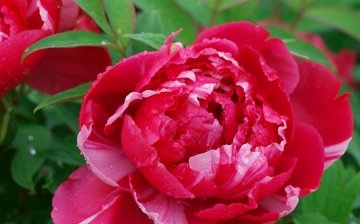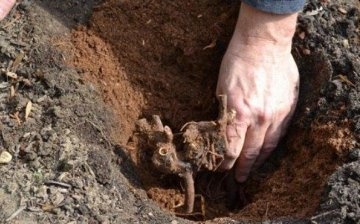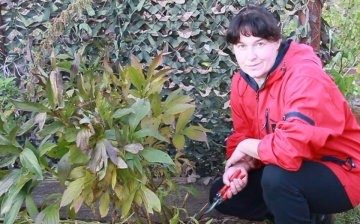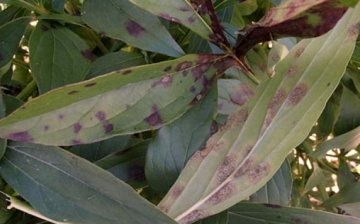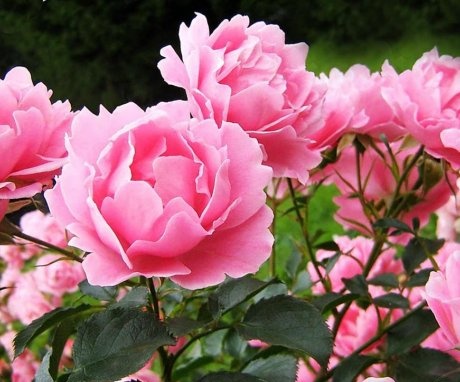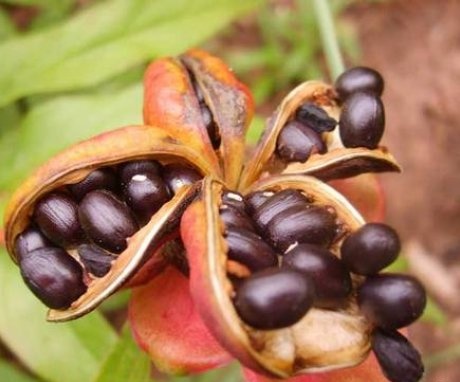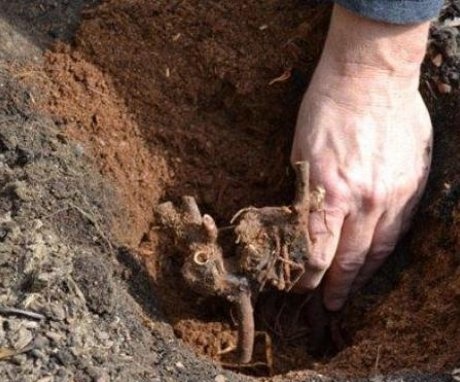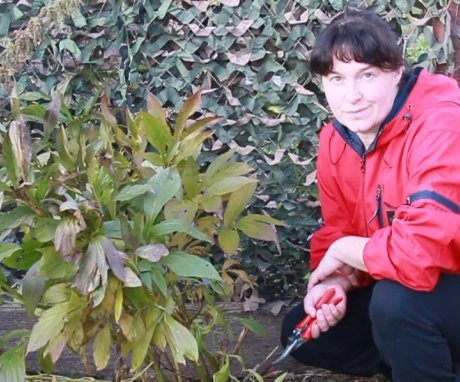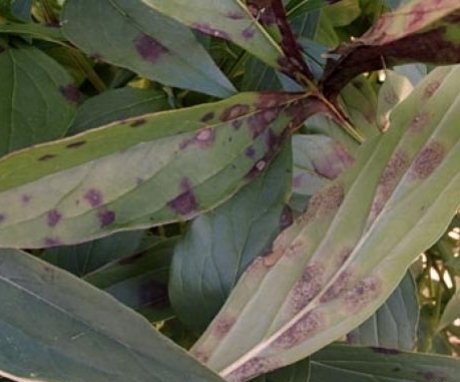Peony: growing and caring for flowers
Peonies - perennial plants with beautiful fragrant flowers. All of them belong to the genus Peony, which has more than 5 thousand varieties. Some of them (about 500) are tree-like, the rest of the stems die off for the winter.
Content:
- Description of the peony
- Types and varieties of peonies
- Reproduction of a peony
- Planting a peony
- Peony care
- Pruning peonies
- Diseases and pests
Description of the peony
Pion - a herbaceous plant that sheds leaves for the winter or a shrub with several trunks. The rhizome is thickened. The buds are covered with scales. The leaves are carved, trifoliate, dark green glossy above, with a grayish tint below. Single flower. Pistils up to 8, many stamens. The petals are large, chipped, in all shades of pink, white, cream and yellow.
Fruits are star-shaped multileafs. The seeds are large, brown. Treelike peonies form a crown in the form of a bush or tree. The rest of the varieties are herbaceous. In one place, they can grow up to 15 years.
At the age of 4-5 years they bloom most magnificently, for the next 5 years they bloom profusely with good care.
The soil for the peony needs loose, loamy. If it is very dense, then before planting, they dig up a plot of 50 cm, add humus, peat, sand and compost... These components increase soil aeration. Acidity pH 5.5-6.5. The sands are too dry for growing peonies. They do not hold water well. Therefore, clay should be applied in such areas.
Types and varieties of peonies
Types of peonies:
- Non-double - with large petals placed in one or 2 rows. The number of petals ranges from 5 to 10. Stamens and pistils of regular shape fill the space inside the flower.
- Japanese are distinguished by stamens of an unusual shape, they can be bent inward. Their color can be the same or contrasting in comparison with the petals. This is a transitional form from a simple to a double flower.
- Anemonic with five or more petals and stamens more petal-like in appearance. Their color may not match the color of the petals.
- Semi-double have several large petals. Their number can be 5 or more. Stamens arranged in circles are of various shapes: common and wide, in the form of a petal. A bouquet of such flowers does not fade for a long time.
- Terry also have five wide petals. There are many smaller petals inside. In some varieties, the middle is filled with pistils and stamens of various shapes. In addition to these familiar forms, there are cactus, Japanese, pink, ito-hybrids.
When buying peonies, you can see letters indicating the flowering period. The word "very" is designated by the letter "O", early - "P", late "P". Therefore, the symbol "OP" denotes a peony with a very late flowering period. Buying varieties with different flowering periods, you can create a flower garden that will decorate the territory for two months.
Popular varieties of peonies:
- Aritina Nozen Glory is a very early flowering variety. The bush grows up to 70 cm, the flower is large, its diameter is 20 cm. The petals are lilac-pink, the stamens are yellow. The leaves are bright green.
- "Pearl placer" is a Japanese type peony. The flower is densely double, 14 cm in diameter, lilac in color. The bush grows rapidly.
- "Snow Mountain" is a short bush that grows up to 75 cm. The flowers are creamy. Needs support. Frost resistant.
- "America" is the same height, but its flowers are red.The diameter of each of them is about 21 cm. The leaves are dark.
Early varieties include:
- "Duchesse De Nemours" is a tall bush (1 m). The diameter of the flower is 19 cm. The color is white with a green tint. Frost resistant. Designed for single and group landings.
- "Mirage" is a tall bush (1.1 m) with fragrant crimson flowers. The stamens are golden. Flower size 13 cm.
Average dates represent varieties:
- "In Memory of Academician Tsitsin" - a tall bush (90 cm). The flowers are cream-colored with a pink tint, yellowish near the center.
- "Spring" - a short bush (85 cm), double flowers. The size of one is 17 cm in diameter.
Mid-late varieties:
- "Sable" is a tall shrub (90 cm) with medium-sized black and red flowers. There are no side buds. The flower is simple.
- "August Dessert" 80 cm high with small double flowers (15 cm). The petals are bright pink, silvery along the edges.
- «Bartzella"- a hybrid variety 90 cm high with large (25 cm) flowers. The petals are yellow, with bright red strokes. Terry flower.
Late varieties:
- "Arkady Gaidar" is distinguished by its bright red flowers of medium size (17 cm). The leaves are decorated with red veins.
- "Anshantress" grows up to 1 m. Flowers are double, white, with a lemon tint and rose scent. Diameter 18 cm.
- "George Peyton" is a tall bush (90 cm). The petals are carved cream, the center of the flower is pink. Size 18 cm. Terry semi-spherical variety with a pleasant mild aroma.
- "Gladys Taylor" grows up to 80 cm. Has double fragrant flowers. Diameter 18 cm.
Reproduction of a peony
Peonies reproduce by dividing the root (seedlings), renewal buds, cuttings, layering, seeds... An adult bush is separated no earlier than 10 years of age.
If you need to propagate a young plant, use growth buds, which are easy to find in early spring. They are cut along with part of the root and stem. Sod land is mixed with sand and humus. Harvested buds are planted. They should be located at ground level. For them to take root, you need to create suitable conditions. Humidity should be at least 80%, temperature from 18 to 20 ° C. Roots will appear in a month and a half.
Cuttings with a bud are harvested in early August, for this, the buds are cut off with a piece of root up to 5 cm long.
Propagating a peony by layering, young stems are sprinkled with the same mixture in spring: earth with peat, sand. A mound 35 cm high is poured. In order to use a lot of layering, a wooden frame with a side of 50 cm and a height of 35 cm is installed around the bush.All summer, a mixture is added to the box: the higher it rises, the more it is poured. The earth should not dry out completely. In the fall, rooted cuttings are pruned near the root and transplanted to a new location.
Peony can be propagated by stem cuttings. For this:
- Before flowering, cuttings are cut so that there are 2 internodes on them. The upper leaves are cut off completely, the lower leaves are left more than half the length.
- The frame is filled with sand, cuttings are planted in it to a depth of about 3 cm. Cover with glass or foil.
- For two weeks they are kept in the shade, regularly ventilated. With this method of propagation, about half of the cuttings are rooted.
You can try to grow a peony from broken rhizomes, even if the buds are not visible on them. Broken areas are cut off, cut into pieces about 7 cm long. The cut points are treated with coal, planted in damp ground. Mulch plot. The next year, dormant buds will sprout on some of the planted roots.
Peonies can be grown from seeds. For this:
- Ripe seeds are collected from the capsules.
- At the beginning of autumn, they are sown in sand boxes located in a greenhouse or a warm room. It is kept at 15-20 degrees for a month and a half, until the seeds hatch, and they will have roots.
- Then they are placed in the cold (1-5 ° C) or buried in the snow for 2 weeks (spend stratification).
- After the boxes are again transferred to a warm room, friendly shoots appear. You just need to remember to moisten the earth.
If it is not possible to pay much attention to the seeds, they are sown immediately after ripening in the ground. In the spring, some of them will rise. The disadvantage of this method is the low germination rate. All seed-grown peonies bloom 4 years or later.
Planting a peony
Planted peonies in August. A site is chosen where the occurrence of groundwater is more than 1 m from the surface. Each peony bush needs an area of 0.5 m2. The place should be well lit, possibly light shading.
When replanting a peony, they do it as quickly as possible, without allowing it to dry out. Prepare a hole up to 70 cm deep.Take a mixture from the excavated earth, humus, ash, superphosphate. Copper sulfate is used for development root system... If the soil is acidic, add lime, bone and dolomite flour. A layer of manure can be placed on the bottom of the pit. It is covered with earth, compacted, flooded with water. The roots of the plant should not come into direct contact with the manure. And by the time they reach the depth of the layer, the manure will crush and become a quality fertilizer.
A peony will bloom and develop better if a drainage layer is laid on the bottom - it is made of broken brick, old wood.
A prepared soil mixture with fertilizers is poured onto the bottom of the pit 2.5-3 weeks before planting. The bush is being prepared for planting. Long roots are cut by a third. Do not allow them to bend or twist. The bush is set so that the buds are at ground level. The pit is covered with fertile soil, leaving no voids. Watering. Usually the bush sags down a little. As a result, the root collar should be 2 cm below the soil level. It is not rammed so as not to damage the roots.
If it is much deeper, then the plant will not bloom for a long time. An exception may be planting a peony on sandy loam soils. There, the depth of the neck can reach 5 cm. With the onset of cold weather, the place where the bush was planted is sheltered from frost with dry leaves and branches.
If a peony bush appeared on the farm unplanned, and there is no way to pull with planting, a method is used that helps the plant to keep at the desired depth. Prepare the pit in the same way as usual, but do not wait for the ground to settle. Take a long stick that will overlap the edges of the pit along the length. Bushes are tied to it and covered with soil. In this case, he is not afraid of subsidence of the earth. The bush will remain at the correct height until spring. Then the stick is removed, having previously added earth instead of the sagging one.
Peony care
After planting, watered as needed. After all, the end of August and September are often dry. So that the soil does not dry out, after watering it is mulched with a thick layer of humus, straw, hay. You can huddle with earth or weathered peat. In the spring, the shelter is removed. But they do it carefully so as not to damage the fragile pink shoots. They appear on the surface early, a little later than tulips... They are in no hurry to remove a layer of humus or peat. Useful substances penetrate into the soil, it warms up better and is supplied with air. The ground around the bush is loosened by 5 cm.
Peonies love moist soil. It is especially important to water the bush on time in the first year after planting. Flowers require moisture in June-July, when buds are laid for flowering the next year. Water it every 7-10 days in the morning, around the bush, trying not to get on the leaves. 10-30 liters of water are poured under one bush. In the fall, watering is stopped.
Feeding peonies:
- For several years, the bush is not fertilized. It feeds on nutrients laid down during planting.
- Then you can use the full complex for feeding mineral fertilizers... For 1 m2, it is brought in 100 g.
- In autumn or early spring, a bucket of compost is poured onto the bush. The peony reacts better to liquid feeding.
- In the spring they are fed twice. A liter of diluted manure is diluted in a bucket of water. Add 20 g of ammonium nitrate, superphosphate and potassium sulfate. It is better to use horse manure. This amount will be enough to water 3 bushes.
- After feeding, the bushes are watered.If the soil is dry, then this should be done before and after fertilizing. Moreover, most of it is poured out at the beginning. After each watering and feeding, the soil is loosened. This helps to retain moisture.
- The peony responds well to feeding "Kemiroi". It is used 3 times during the growing season. In early spring, fertilizer "Kemira Universal" is applied, repeated after flowering. During the formation of buds, the Kemira-Kombi product is used.
- Horse manure mulching promotes abundant flowering. But if the bushes get sick, then they do not use it, like others. organic fertilizers.
- After flowering, foliar feeding is carried out, spraying with a solution of trace elements.
- Excessive fertilization can harm the peony. To feed the deep roots of adult bushes, wells with a diameter of up to 10 cm are punched and filled with dry chicken manure and superphosphate in equal parts. The next time this feeding will need to be repeated after 3 years.
In most cases, peony bushes need to be tied up, otherwise they fall apart, flowers fall to the ground. Stakes are often used for support, but they spoil the aesthetic appearance of the bush. Therefore, it is better to take a metal rod with a loop through which a cord or wire is threaded.
Pruning peonies
Correct pruning helps to regulate the strength of flowering, the number and size of flowers. If the peony is going to bloom in the first year after planting, the buds need to be cut off. This will make the bush stronger. Several flowers are left the next year.
You can adjust the size of the flower by cropping.
To do this, cut off the unblown lateral buds the size of a large pea, leaving one central one. And the number of central shoots is reduced by a third, plucking.
In order for the bush to bloom magnificently next year, cutting off the flowers, 3 leaves are left on the shoot. For the same reason, do not cut the low green leaves of the peony after the bush has faded. In late autumn, all the stems are cut off, removed from the site and burned. This is done carefully so as not to damage the congested kidneys.
Diseases and pests
The main problem of growing peonies - lack of flowers for a long time. This can be caused by many factors:
- Old bush.
- Too young bush.
- Acidic soil.
- Excessive amount of fertilizer.
- Drought or waterlogging.
- Very dense soil.
- Frost damage.
- Diseases.
The main disease of peonies is gray rot. It can infect the plant in high humidity, especially when combined with high temperatures. The disease is manifested by wilting of the stems. To prevent the disease, sprinkle the soil around the bush ashusing a glass of 1 m2. Bushes on which the disease was noticed are sprayed fungicides, and in the spring they water the soil under the bushes with their solution.
After flowering, they are sprayed 2 times with copper-containing preparations. In order for the plants to be less affected, it is necessary to allocate sufficient area for the bushes.
More information can be found in the video:





